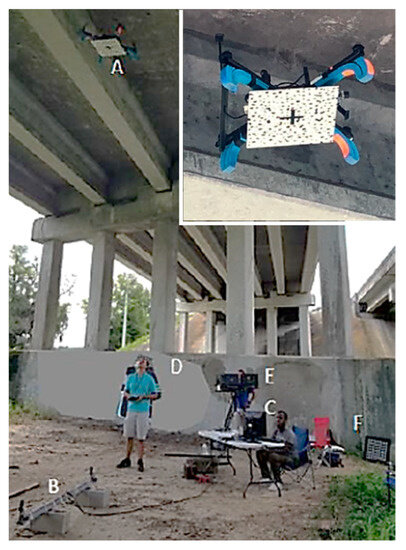New Research Featuring DIC from Correlated Solutions
Over the past few months, there has been a flurry of publications featuring the industry-leading VIC-3D and VIC-2D systems across many disciplines. The open-access studies below present current research into high-tech concrete, ballistics, and UAS bridge inspections, and they all use powerful digital image correlation systems developed by Correlated Solutions.
Effect of the Combination of Superabsorbent Polymers for Autogenous Shrinkage Control with Steel Fibers of High-Performance Concrete under Uniaxial Tension Using DIC.
Abstract: This paper presents a study of the effect of a superabsorbent polymer (SAP) for autogenous shrinkage control on the uniaxial tensile behavior of steel fiber reinforced concrete (SFRC). The use of fibers and SAP potentially increases the durability of the concrete, preventing cracking by autogenous shrinkage and enhancing post-cracking behavior. Furthermore, SAP can provide further hydration for self-healing purposes and improve the ductility of the SFRC. In order to evaluate the effect of the addition of SAP in SFRC, dog-bone SFRC specimens with different dosages of superabsorbent polymers were cast and tested under uniaxial tension. The digital image correlation (DIC) technique was used to understand the effect of SAP on the steel fibers’ crack-bridging mechanisms. Surface strains and crack openings were inferred using the DIC technique. The effect of SAP and fibers on fresh and hardened concrete was individually investigated by flow tests and compressive strength tests. Autogenous shrinkage was measured in plain concrete to investigate the minimum SAP content required to mitigate autogenous shrinkage of 0.3%. The use of 0.3% SAP was also sufficient to reach multiple cracking behavior. This content of SAP completely suppressed the autogenous shrinkage with minimal side effects on compressive strength. An analytical formulation for the tensile behavior of SFRC was developed using the variable engagement model, presenting a mean correlation of R2 of 0.97 with the experimental results.
Santos, K.F.; Ribeiro, A.C.B.S.; Silva, E.F.; Manzano, M.A.R.; Motta, L.A.C.; Toledo Filho, R.D. Effect of the Combination of Superabsorbent Polymers for Autogenous Shrinkage Control with Steel Fibers of High-Performance Concrete under Uniaxial Tension Using DIC. Materials 2020, 13, 4638.
Comparative Analysis of Object Digitization Techniques Applied to the Characterization of Deformed Materials in Ballistic Tests
Abstract: Several three-dimensional scanning methods have been developed and improved over the past 40 years. The peculiarities of each technique, associated with the computational advances of the period, allowed the increasing application and diffusion of the technology in several sectors, among them those related to metrology in ballistics and the testing of protective materials. The specific goal of such ballistic tests is to estimate the depth of indentation caused by projectiles. In particular, this study presents a comparative analysis between two three-dimensional optical scanning methods, taking into account the same object of interest. The comparative analysis was based on reference planes detected by Random Sample Consensus methodology in each cloud. By comparing the results of the different techniques, it was found for this case that three-dimensional reconstruction by stereo images estimated values closer to the real ones in comparison to those estimated by the structured light scanner, mainly due to the fact that, for three-dimensional reconstruction, the image acquisition was conducted statically.
Dmengeon Pedreiro Balbino, F.; Aracélly Reis Medeiros, K.; Roberto Hall Barbosa, C. Comparative Analysis of Object Digitization Techniques Applied to the Characterization of Deformed Materials in Ballistic Tests. Sensors 2020, 20, 5017.
Comparative Analysis of Object Digitization Techniques Applied to the Characterization of Deformed Materials in Ballistic Tests
Abstract: Bridge inspections are an important procedure for maintaining the infrastructure vital to our economy and well-being. The current methodology of utilizing specialized equipment such as snooper trucks and scaffolding to support manned-inspections poses a significant financial cost, disrupts traffic, and is dangerous to the inspectors and public. The advent of unmanned aerial systems (UAS), more commonly called drones, presents a practical solution that promises reduced cost, enhanced safety, and is significantly less intrusive than previous methodologies. Current limitations in the implementation of UAS include the reliance on a skilled operator and/or the requirement for a UAS to operate in a cluttered, GPS-denied environment. A solution to these challenges is presented in this paper by utilizing commercial off-the-shelf (COTS) hardware including laser rangefinders, optical flow sensors, and live video telemetry. Included in the system is the obstacle avoidance equipped drone and a ground station intended to be manned by a pilot and bridge inspector. The proposed custom-fabricated UAS was implemented during eight inspections of Florida Department of Transportation (FDOT) bridges. The UAS was able to navigate under GPS-denied and obstacle-laden bridge decks with position-hold performance comparable to, if not better than, a COTS unit in an unobstructed environment. The position hold capability maintained an altitude of ±12.8 cm with a horizontal hold of ±435 cm. Details of the hardware, algorithm development, and suggestions for future research are discussed in this paper.
Whitley, T.; Tomiczek, A.; Tripp, C.; Ortega, A.; Mennu, M.; Bridge, J.; Ifju, P. Design of a Small Unmanned Aircraft System for Bridge Inspections. Sensors 2020, 20, 5358.




